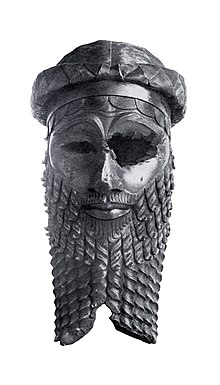Reginald Campbell Thompson: Difference between revisions
Added to info box |
|||
| Line 12: | Line 12: | ||
| death_date = {{death date and age|df=y|1941|05|23 |1876|08|21}} |
| death_date = {{death date and age|df=y|1941|05|23 |1876|08|21}} |
||
| death_place = Sowberry Court, [[Moulsford]] |
| death_place = Sowberry Court, [[Moulsford]] |
||
| death_cause = Heart failure<ref name=obit>{{cite news|title=A leading Assyriologist|location=London|newspaper=The Times|page=6|date=6 May 1941}}</ref> |
|||
| death_cause = |
|||
| resting_place = St Leonard's Churchyard, Sunningwell |
| resting_place = St Leonard's Churchyard, Sunningwell |
||
| fields = Archaeology, Assyriology and Cuneiform |
| fields = Archaeology, Assyriology and Cuneiform |
||
Revision as of 12:01, 29 March 2024
Reginald Campbell Thompson | |
|---|---|
| File:Reginald Campbell Thompson.jpg Reginald Campbell Thompson © National Portrait Gallery, London | |
| Born | 21 August 1876 Cranley Place, South Kensington |
| Died | 23 May 1941 (aged 64) Sowberry Court, Moulsford |
| Cause of death | Heart failure[1] |
| Resting place | St Leonard's Churchyard, Sunningwell |
| Education | Colet Court, St Paul's School |
| Alma mater | Caius College, Cambridge |
| Known for | Excavations at Nineveh |
| Spouse | Barbara Brodrick Robinson |
| Children | 3 |
| Scientific career | |
| Fields | Archaeology, Assyriology and Cuneiform |
Reginald Campbell Thompson (21 August 1876 – 23 May 1941) was a British archaeologist, Assyriologist, and cuneiformist. He excavated at Nineveh, Ur, Nebo and Carchemish among many other sites.
Biography
Thompson was born at Cranley Place, South Kensington, the eldest of five children of Dr Reginald Edward Thompson (1834-1912) and Anne Isabella De Morgan,[2] and educated at Colet Court, St Paul's School and Caius College, Cambridge, where he read oriental (Hebrew and Aramaic) languages.

In 1904 he found the remains of the temple of Nabu in Nineveh,[3] which were destroyed in 2016 by the Islamic State of Iraq and the Levant.
In 1918 Mesopotamia fell into British hands, and the trustees of the British Museum applied to have an archaeologist attached to the army in the field to protect antiquities from injury. As a captain in the Intelligence Service serving in the region and a former assistant in the British Museum, R. C. Thompson was commissioned to start the work. After a short investigation of Ur, he dug at Shahrain and the mounds at Tell al-Lahm.
After the First World War he held a fellowship at Merton College, Oxford.[4] Thompson was a member of the Royal Asiatic Society, and left to them two canisters of film. "The footage dates from the late 1920s/early 1930s and shows excavations in Iraq at the mound of Kouyunjik, scenes in the village of Nebi Yunus, across the Khosr river from Kouyunjik within the ancient city boundaries of Nineveh, and scenes in the city of Mosul, across the river Tigris from Nineveh". The film was digitised in 2016.[2]
The writer Agatha Christie was invited by Thompson, along with her husband the archaeologist Max Mallowan, to the excavation site at Nineveh in 1931.[5] She dedicated her story Lord Edgware Dies to "Dr and Mrs Campbell Thompson". In return he dedicated his melodrama in blank verse Digger's Fancy to "Agatha and Max Mallowan".[6]
Personal life
Reginald Campbell Thompson married Barbara Brodrick Robinson at St John’s, Putney on 19 September 1911. They had three children: Yoland(e) in 1914, Reginald Perronet in 1919 and John De Morgan in 1923. Reginald Perronet was a Flight Lieutenant in the RAFVR, and was killed on active service on 4 April 1941.[7]
Reginald died on 23 May 1941 at Sowberry Court, Moulsford, aged 64. He lost his life while serving in the Home Guard, during a patrol on the River Thames.[7]
Barbara accompanied her husband on site for all four seasons of work at Nineveh.[2] She died on 25 June 1971, aged 84. Reginald, Barbara and their first son are buried at Sunningwell, close to the family home at Boars Hill.
Bibliography
- A Century of Exploration at Nineveh. London, Luzac, 1900. Joint author: Richard Wyatt Hutchinson.
- The Devils and Evil Spirits of Babylonia, 2 vols. London, Luzac, 1903–1904.
- Late Babylonian Letters: Transliterations and Translations of a Series of Letters Written in Babylonian Cuneiform, Chiefly during the Reigns of Nabonidus, Cyrus, Cambyses, and Darius. London, Luzac, 1906.
- Semitic Magic: its Origins and Development. London, 1908.
- A Pilgrim's Scrip;. London, John Lane The Bodley Head, 1915.
- Archaeologia, Vol LXX (1921)
- The epic of Gilgamish, text, transliteration and notes. 1930.
- Fiction
- A song of Araby (1921 as John Guisborough)
- A Mirage of Sheba (1923 as John Guisborough)
- Digger's Fancy: a Melodrama. London, Sidgwick & Jackson, 1938.
References
- ^ "A leading Assyriologist". The Times. London. 6 May 1941. p. 6.
- ^ a b c "Reginald Campbell Thompson and the Nineveh Project". Royal Asiatic Society of Great Britain and Ireland. Retrieved 25 March 2023.
- ^ British Museum: Reginald Campbell Thompson
- ^ Levens, R.G.C., ed. (1964). Merton College Register 1900–1964. Oxford: Basil Blackwell. p. 156.
- ^ McCall, Henrietta. "British Museum: Agatha Christie and Archaeology". Archived from the original on 27 September 2011. Retrieved 15 December 2011.
- ^ "Archaeologists in Print".
- ^ a b Kinnear, Jennifer (11 November 2020). "Archive Report: Allied Forces". Aircrew Remembered. Retrieved 26 March 2023.
Sources
- British Museum collections
- Harry Reginald Holland Hall, A season's work at Ur, Al-'Ubaid, Abu Shahrain (Eridu) and Elsewhere, Being an Unofficial Account of the British Museum Archaeological Mission to Babylonia, 1919, Methuen, 1930.
